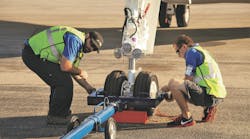Configuration Deviation Lists
This may sound shocking, but stuff falls from airplanes when they are in flight.
It was quite common years ago that when non-structural elements on the exterior of the airplane were found missing,
an engineering assessment would be made. If okay, the airplane would be returned to service until a replacement for the missing item could be obtained and reinstalled. We found ourselves contacting the manufacturers for help in assessing the missing items. We began to make up lists of these items and called them Missing Parts Lists. The lists were reviewed and accepted by our Principle Operations Inspector.
In the late 1960s, the FAA expressed their concerns about these lists and the deferral of missing items. Ultimately, the FAA disallowed the use of missing parts lists with the position that an airplane flying with missing external parts was not in the original certificated configuration, thus, it was not airworthy. The reason being that no one knew what effects a missing item would have upon airplane
performance and handling qualities. As a result, the Configuration Deviation List (CDL) arose from the ashes of the Missing Parts List.
The CDL is a listing of FAA-approved non-structural external parts that may be missing but the airplane remains airworthy.
It is contained in an approved airplane flight manual (AFM) appendix. To qualify an item onto the CDL, a restrictive set of conditions must be met. This was done to assure that the list remained small and purposeful. Some of these conditions include:
1. The effect of the missing part upon adjacent structure and systems must be evaluated. The qualification of an item must be deemed feasible by an engineering review. The configuration of the airplane must not pose an obvious threat to the airplane. Consider
qualifying a missing refueling bay door on the underside of the wing. What is the air load imposed upon the fueling panel and in the wing cavity behind the missing door? Will the refueling panel be damaged?
2. The effect upon airplane performance must be measured. What is the drag penalty imposed upon the airplane when flying with the part missing? Will the missing part affect performance
limited operating weights?
3. What is the combined effect upon the
airplane when more than one CDL item is present on the airplane? Will certain combinations of items result in a hazardous condition?
The airplane must undergo a flight test (which is extremely costly), with the subject item missing and must include
an assessment of the flying qualities of the airplane out to VD/MD. The airplane may not exhibit any handling problems including flutter evaluation.
One or two instances of an item shown missing from the airplane will not justify the effort or the expense. Today, most
items on the CDL are qualified during the initial certification of the airplane and CDL test flights are scheduled into the test plan. A list of items, based upon experience with previous designs, is selected during initial airplane design.
A plan defining the conditions for the test is developed. Data from the flight test and pilot evaluations are analyzed and then submitted to the FAA for review. If accepted, the item is included into the CDL. Appropriate performance and operating limitations may be
listed with the item.
The CDL should not be confused with the
Minimum Equipment List (MEL). MELs are associated with inoperative equipment and systems. They define a safe deviation from the certified configuration. Items listed in the CDL, however, define a new certificated airplane configuration. Therefore, the airplane may be flown indefinitely without replacing a qualified missing part. In practice, the part is usually replaced at the first convenient opportunity, but it is important to remember that the airplane remains airworthy regardless of the time the airplane flies with an open CDL item.
On the line, procedures to handle CDL items consist of the administrative practices necessary to release the airplane and include log entries, down line, pilot and dispatch notification. Also included will be any maintenance limitations associated with the missing item.
A CDL is an extremely important tool for continuing operations. They allow us to safely "push tin."





